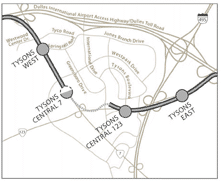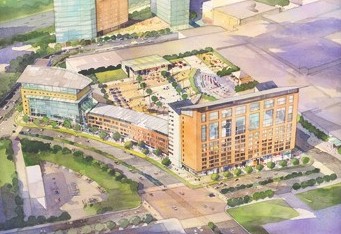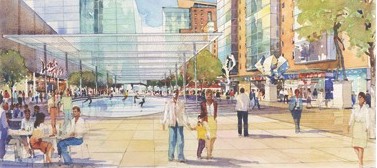|
The
proposed extension of the Washington METRO system to Dulles Airport is one of the most expensive
infrastructure projects ever conceived in the state
of Virginia. The projected cost is $4 billion,
assuming no expensive delays or overruns. "Rail
to Dulles," as the project is known in
shorthand, is vitally necessary for the economic
health of Northern Virginia. But, as currently
conceived, the project would precipitate a
multibillion- dollar transfer of wealth from
taxpayers and commuters to politically powerful land
owners.
The
plan for financing Rail to Dulles has three main
components: The federal government will pay 50
percent, the state will pony up 25 percent, while
Fairfax County, Loudoun County and the Metropolitan
Washington Airports Authority will chip in the other
25 percent.
Where
will the state get its $1 billion share of the
money? From the commuters who drive along the Dulles
Toll Road -- commuters who had been promised that
the tolls would be scrapped once the original
construction bonds had been paid off.
And
who will benefit from Rail to Dulles? Commuters will
receive some benefit, to be sure, in the form of
reduced congestion. The METRO line, which will run
down the Toll Road right of way, will divert some
traffic from the highway to rail cars. But the
biggest winners will be the owners of land near the
11 new rail stations.
To
get an idea of how much wealth will be created by
Rail to Dulles, consider this: The current assessed
value of the commercial property in just the Phase 1
special tax district, concentrated in Tysons Corner,
is $9 billion to $10 billion.
Fairfax County is contemplating changes to its
comprehensive plan that would increase allowable
square footage of non-residential development
(offices, retail, hotels) by 43 percent and
residential development by 151 percent.(1)
Those zoning
changes in Tysons Corner potentially could translate into an
additional $4 billion in property assessments. And that
doesn't include the boost to property
within walking distance of the METRO stations, which
could easily double in value.
Add
it all up, and the increase in property values for just
Tysons Corner could well exceed $5 billion. But
the contribution of commercial property owners to
Phase 1 METRO financing would be capped at $400 million.
The
mismatch between property owners' contributions to
financing Rail to Dulles and the benefits they can
anticipate receiving are unconscionable. How
Republicans, who supposedly abhor government
giveaways, can tolerate such a lopsided distribution
of benefits is beyond
me. That Democrats, who purportedly believe in
transferring wealth from the wealthy to the poor -- not the
reverse -- can
countenance this arrangement is even more of a
mystery.
Rail
to Dulles has so much bureaucratic momentum behind
it, however, that it may be impossible to derail.
Suggestions that a Bus Rapid Transit system could
provide comparable mobility at a fraction of the
cost(2) have been swept aside. And, as intriguing as
the concept is, Personal Rapid Transit, a
21st-century permutation of mass transit(3), is still too
untested and unproven to gain popular support within
a politically acceptable time frame.
Given
the political realities that something must be done
now, and it must be done within the broad framework
already in place, there are two key points I
would emphasize:
First,
Rail-to-Dulles must be built. The project is crucial
to the economic vitality of Northern Virginia for
two reasons: (a) It will relieve traffic congestion
by taking thousands of cars off the region's roads,
and (b) it will provide the impetus to re-fashion
Tyson's Corner from the jumbled mess that it is now
into a world-class, transit- and pedestrian-oriented business
center.
Second,
sufficient economic value will be created that
everyone can come out a winner. There is no need to
plunder the mostly middle-class commuters who ride
the Dulles Toll Road. The tools exist to make
commercial property owners pay the full cost of the
project and still come out ahead.
Tysons
Corner is the most important business center in
Virginia. It accounts for more economic activity
than downtown Richmond, downtown Norfolk or even the
burgeoning Reston-Herndon technology center to the
west. The concentration of technology expertise,
human capital and entrepreneurial ferment has few peers around the country.
In
a testament to its business vitality, Tysons
prospers in spite of its grave flaws as a locus of
urban activity. Although
individual buildings may have architectural flair,
the business district is an aesthetic disaster. Visually, there are few memorable vistas or
focal points. A flotsam of mid-rise
buildings is awash in expansive parking lots, and
development is bifurcated by streets designed to move cars, not
people. Functionally, there is no pedestrian life:
It's easier to cross the street by driving from one
parking lot to the next than to make the trip on
foot.
Perhaps
most serious of all, there is a massive imbalance
between commercial and residential development. As a
consequence, tens of thousands of employees converge
on Tysons every morning from around the region,
adding immeasurably to traffic congestion in the
business center itself and the arteries leading
into it.
Addressing
these deficiencies, even in part, could create a
world-class business district. However, a makeover
will cost billions of dollars. Extending METRO
through Tysons Corner is the only way that would
stimulate the level of investment required.
|

|
Under
existing plans, the Rail-to-Dulles extension
would tie into the Washington METRO line near
the West Falls Church station on the orange
line. It would run north to Tysons Corner and
then hook up with |
the
Dulles Toll Road. In Phase 1, a $1.8 billion
project, the METRO would extend as far as Wiehle
Ave. on the eastern fringe of Reston.
In
Phase 2, the METRO would thrust past the employment
centers of Reston and Herndon, loop down to Dulles
Airport, and then continue west into Loudoun County.
In total, eight stations would reside in Fairfax
County, one in Dulles Airport and two in Loudoun
County.
The
first benefit to Northern Virginia would be
congestion relief. Rail
boosters assert that peak hour capacity would
equal four new lanes on the Dulles Toll Road,
accounting for an estimated ridership of 35,000 to
38,000 daily boardings. (Assuming most passengers
account for two daily boardings, one each way, that
would translate into 17,500 to 19,000 passengers per
day.)
That
aspect of the plan has gotten most of the attention
-- down here in Richmond, at least. But
equally significant, perhaps more so, are the
changes to Tysons Corner land use. The high-density
development that would cluster around the four METRO
stations would be so profitable that developers
could afford to bulldoze many existing
buildings, parking lots, side streets and related
infrastructure and rebuild the urban fabric from
scratch.
As
just one example of what could be in store for
Tysons Corner, consider Tysons Corner Center, a
project of the Macerich Company. Macerich, a
California-based Real Estate Investment Trust, is
one of the largest owner/ operators of regional
malls in the country. With anchor tenants such as
Nordstrom, Bloomingdale’s, Hecht’s and Lord
& Taylor, Tysons Corner Center, located on Rt.
123, is one of the largest malls in the Washington
metro area.

Rendering
taken from the www.tysonsfuture.com
website.
Under
the Macerich plan, the mall would remain in place,
but the land around it -- including a Circuit City
store and acres of parking lots -- would be
transformed. The company's ambition is to create
"a world-class community around the center
where people can live, work, walk and shop in a
vibrant, connected neighborhood." Plans call
for adding:
-
Four
office buildings containing 1.4 million square
feet
-
Four
residential buildings offering up to 1,250 new
units
-
A
240-room hotel
-
Street-level
restaurants and retail adding up to 200,000
square feet
-
An
ice rink, plaza, courtyards, water fountains,
performance stage, sky terrace and public art.
As
a mixed-use, "transit oriented
development," Tysons Corner Center would plug
directly into a Metro Rail station. Macerich would
make improvements to Rt. 7 and Rt. 123, and it would
provide connectivity by means of sidewalks, bike
paths, walkways and
improved bus/shuttle service. In marked contrast to
the auto-centric pattern of development that exists
now, this new community would encourage people not
only to use the METRO but to walk, bicycle, take
shuttles and ride buses -- eliminating thousands
more automobile trips every day.

Rendering
taken from the www.tysonsfuture.com
website.
One
of the most ambitious projects on the Fairfax County
drawing boards, Tysons Corner Center exemplifies the
grandiose scale of the redevelopment that could take
place, transforming Tysons Corner beyond
recognition. Given the square footage that would be
added by the zoning changes under discussion, Tysons
could accommodate another dozen Macerich-scale
projects. Rail to Dulles would catalyze billions
of dollars of real estate investment over a 10-
to 20-year period. The economic development
potential is breath-taking.
As
spectacular as the benefits of transit-intensive
development would be for Fairfax County, the positive
impact would ripple across Northern Virginia -- even
beyond the metropolitan fringe. The 12,500 housing
units built in Tysons Corner -- providing shelter
for some 25,000 residents -- would not have
to be built in Fauquier County, Stafford County or
western Loudoun County.
I cannot emphasize enough: The only way to prevent
hop-scotch, disconnected, low-density development on
the metropolitan periphery, where such development
is expensive, disruptive and unwanted, is to create more compact, densely
settled communities in metro Washington's core
jurisdictions. (The same logic applies on a lesser
scale to metropolitan Richmond and Hampton Roads.)
In
sum, Rail to Dulles is crucial to the future not
only of Fairfax and Loudoun Counties but to all of
Northern Virginia and all the counties in its
economic orbit.
But as much as the initiatives like
Tysons Corner Center should be encouraged, it would
near-criminal folly for state and county policy
makers allow landowners like Macerich to reap 90
percent of the economic value created by
construction of the rail line paid for with 90
percent public funds.
In
an ideal world, it would
be possible
to finance the construction of Rail to Dulles without
creating massive transfers of wealth to rich
landowners. Here's a schematic outline of how it can
be done if special-interest politics doesn't interfere.
First
some background: Fairfax
County has established a special tax district that
allows the County to levy an additional tax -- $0.22
per $100 of assessed value -- on commercial property
owners within the district. That rate could increase a few
pennies, but under no circumstance can it exceed
$0.40 per $100 annually. Furthermore, the
total tax obligation is capped at $400 million. As
things now stand, that is the full liability of
property owners for Phase 1 of the project.
Not
all landowners will come out ahead under the current
financing scenario. Those whose properties are
located closest to METRO stations will see the
greatest increase in value, while those located more
than a half mile distant will see only marginal
increases in value. Some landowners will get
fabulously rich from METRO while others will get
very little from it. Yet everyone within the tax
district would pay on the same basis. Bottom line: The tax
district is an engine of inequity
and it needs to be deep-sixed.
But
first things first. Before creating a new tax
district, Fairfax and Loudoun County planners need
to figure out what kind of land use they want around
their METRO stops. I would argue that the counties'
comprehensive plans should permit extremely high
densities above the METRO stations, should tone down
the density within a 1/4-mile walking distance, and should let densities taper off at greater
distances. In effect, there would be a central,
high-density point at each METRO station surrounded by concentric rings of
diminishing density, modified by geographical
features such as streams, gullies, major
thoroughfares, existing town centers and the like.
Then,
and only then, would planners configure Community
Development Authorities (CDAs) over the high-density
zones. The CDAs would have the power to issue bonds
to pay for their share of the METRO stations, rail
line, parking decks and other improvements required
to enhance the accessibility of the stations.
Landowners
near the METRO stations would get a giant two-fer from this arrangement: (1)
a massive increase in permitted density, and (2)
proximity to a METRO station. Spread across 11 METRO
stations, the real-estate value added
would amount to billions of dollars.
Under
the cost-sharing formula now in place, state and
local authorities will have to pick up a total of
$2 billion -- perhaps more in the event of cost
overruns or design changes such as running the
Tysons METRO line underground. If the debt were
spread across 11 stations, each CDA would need to
issue on average about $200 million in bonds. The
annual debt service on 30-year notes would be, in
very rough numbers, about $10 million per year.
To
pay off the bonds, planners
then would superimpose special tax districts over
the CDAs. Under this arrangement, only the landowners who benefited most
directly from the public improvements would be
forced to pay the special tax. Landowners outside a
1/4-mile to 1/2-mile radius, who enjoy neither increased density
nor proximity to METRO stations, would not pay the
higher tax rate. Commuters using the Dulles Toll
Road, who have already paid for construction of
their highway, would not have to continue paying
tolls to fund construction of the METRO as well.
(Maintaining tolls may be justified as a means to
continue funding improvements to the toll road, but
that's a different issue.)
Ideally,
the CDAs and tax districts would be structured to
ensure that nobody loses and everybody wins: Those
who pay the taxes would be more than compensated by
the soaring economic value of their property and the
returns they could generate from it.
As long as
their riches aren't coming at the expense of someone
else, I have no problem with landowners like
Macerich Company making loads and loads of money.
That's capitalism, baby! You gotta love it. But if
their riches come at the expense of other landowners
and powerless commuters, I have a huge problem.
That's state-sanctioned theft.
The
Kaine administration undoubtedly feels under
pressure to get the project moving -- that's why it
turned over responsibility for the project to the
Metropolitan Washington Airports Authority. Finding
an alternative to the current, patently unjust
funding formula could delay the project for months,
so I don't imagine that the people in charge have
any appetite for
reopening discussions. But if the Kaine crew
stumbles blindly ahead on its current course, it will play Robin Hood in reverse:
robbing middle class commuters and giving to the rich and
powerful. Among voters, there will be far more
losers than winners, and they may find a voice come
election time.
--
May 15, 2006
Footnotes
1.
These numbers come from a Fairfax County
planning department PowerPoint presentation. See the
tables on page 19 of the document.
2.
See William Vincent's column, "Three
Big Ideas," Jan. 16, 2006.
3.
See Ed
Risse's column, "The
Problem with 'Mass' Transit," May 15, 2006
|
